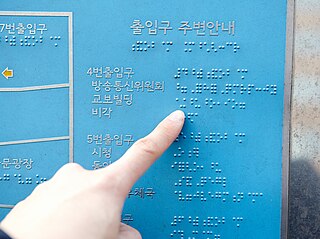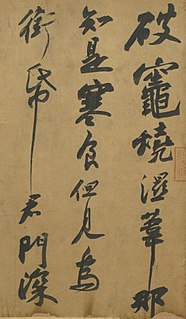 W
WKorean is an East Asian language spoken by about 80 million people, mainly Korean, as of 2020. It is the official and national language of both North Korea and South Korea, with different standardized official forms used in each country. It is a recognised minority language in the Yanbian Korean Autonomous Prefecture and Changbai Korean Autonomous County of Jilin Province, China. It is also spoken in parts of Sakhalin, Russia and Central Asia.
 W
WKorean Braille is the braille alphabet of the Korean language. It is not graphically-related to other braille scripts found around the world. Instead, it reflects the patterns found in hangul, and differentiates initial consonants, vowels, and final consonants.
 W
WClassical Chinese, also known as Literary Chinese, is the language of the classic literature from the end of the Spring and Autumn period through to the end of the Han dynasty, a written form of Old Chinese. Classical Chinese is a traditional style of written Chinese that evolved from the classical language, making it different from any modern spoken form of Chinese. Literary Chinese was used for almost all formal writing in China until the early 20th century, and also, during various periods, in Japan, Korea and Vietnam. Among Chinese speakers, Literary Chinese has been largely replaced by written vernacular Chinese, a style of writing that is similar to modern spoken Mandarin Chinese, while speakers of non-Chinese languages have largely abandoned Literary Chinese in favor of their respective local vernaculars. Although languages have evolved in unique, different directions from the base of Literary Chinese, many cognates can be still found between these languages that have historically written in Classical Chinese.
 W
WThe geographically close Japanese and Korean languages share considerable similarity in typological features of their syntax and morphology while having a small number of lexical resemblances and different native scripts, although a common denominator is the presence of Chinese characters, where kanji are part of Japanese orthography, while hanja were historically used to write Korean. Observing the said similarities and probable history of Korean influence on Japanese culture, linguists have formulated different theories proposing a genetic relationship between them, though these studies either lack conclusive evidence or were subsets of theories that have largely been discredited.
 W
WThe Kontsevich system is a cyrillization system for the Korean language and currently the main system of transcribing and transliterating Korean words into the Cyrillic alphabet. The Kontsevich system was created by the Soviet-Russian scholar Lev Kontsevich in the 1950s based on the earlier transliteration system designed by Aleksandr Kholodovich.
 W
WThe Korean alphabet, known as Hangul in South Korea and Chosŏn'gŭl in North Korea, is a writing system for the Korean language created by King Sejong the Great in 1443. The letters for the five basic consonants reflect the shape of the speech organs used to pronounce them, and they are systematically modified to indicate phonetic features; similarly, the vowel letters are systematically modified for related sounds, making Hangul a featural writing system. Much of the Korean alphabet shows the influence of Chinese characters on the Korean characters.
 W
WThe Korean Alphabet Day, known as Hangeul Day (한글날) in South Korea, and Chosŏn'gŭl Day in North Korea, is a national Korean commemorative day marking the invention and the proclamation of Hangul, the alphabet of the Korean language, by the 15th-century Korean monarch Sejong the Great. It is observed on October 9 in South Korea and on January 15 in North Korea. Excluding the years 1990 to 2012, when the government maximized business days to expedite industrial growth, Hangul day has been a national holiday in South Korea since 1970.
 W
WHanja is the Korean name for a traditional writing system consisting mainly of Chinese characters that was incorporated and used since the Gojoseon period (400 BC). More specifically, it refers to the Chinese characters incorporated into the Korean language with Korean pronunciation.
 W
WMany East Asian scripts can be written horizontally or vertically. Chinese, Japanese, Vietnamese Chữ Nôm and Korean scripts can be oriented along either axis, as they consist mainly of disconnected logographic or syllabic units, each occupying a square block of space, thus allowing for flexibility for which direction texts can be written, be it horizontally from left-to-right, horizontally from right-to-left, vertically from top-to-bottom, and even vertically from bottom-to-top.
 W
WHunminjeongeum Haerye, or simply Haerye, is a commentary on the Hunminjeongeum, the original promulgation of hangul. The Hunminjeongeum Haeryebon (訓民正音解例本) is the printed edition—bon (本) means "book" or "edition".
 W
WA number of Korean dialects are spoken on the Korean Peninsula. The peninsula is extremely mountainous and each dialect's "territory" corresponds closely to the natural boundaries between different geographical regions of Korea. Most of the dialects are named for one of the traditional Eight Provinces of Korea. One is sufficiently distinct from the others to be considered a separate language, the Jeju language.
 W
WThe Nogeoldae is a textbook of colloquial northern Chinese published in Korea in several editions from the 14th to 18th centuries. The book is an important source on both Late Middle Korean and the history of Mandarin Chinese. Later editions were translated into Manchu and Mongolian.
 W
WTally marks, also called hash marks, are a unary numeral system. They are a form of numeral used for counting. They are most useful in counting or tallying ongoing results, such as the score in a game or sport, as no intermediate results need to be erased or discarded.
 W
WThe Thousand Character Classic, also known as the Thousand Character Text, is a Chinese poem that has been used as a primer for teaching Chinese characters to children from the sixth century onward. It contains exactly one thousand characters, each used only once, arranged into 250 lines of four characters apiece and grouped into four line rhyming stanzas to make it easy to memorize. It is sung in a way similar to children learning the Latin alphabet sing an "alphabet song." Along with the Three Character Classic and the Hundred Family Surnames, it has formed the basis of literacy training in traditional China.
 W
WZainichi Korean is a variety of Korean as spoken by Zainichi Koreans. The speech is based on the southern dialects of Korean, as the majority of first-generation immigrants came from the southern part of the peninsula, including Gyeonggi-do, Jeolla-do and Jeju-do.